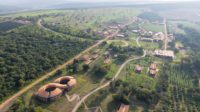Preservationists Fight to Save a Model of Resort Design in Canary Islands








On the island of Gran Canaria, a last-minute battle wages to save the Maspalomas Oasis Hotel, designed by the Madrid architects José Antonio Corrales and Ramón Vázquez Molezún and completed in 1971. Weaving together pavilions, gardens, and courtyards, and preserving a virgin grove of palms, the project is a model for harmonious intervention in the unique volcanic landscape of the Canary Islands.
The owners, the hotel chain RIU, plan to close the hotel and begin demolition in April, replacing the building for an increase from 633 to 950 rooms. And local authorities have encouraged the move, targeting the hotel for redevelopment as part of a plan to renovate the area's aging resort facilities, with an increase in permissible built area from four to five stories as an incentive.
The hotel currently lacks protection from such destruction, though it is included in a proposed catalogue of 20th Century Heritage prepared for Spain's Ministry of Culture by the Docomomo Iberico Foundation (Documentation and Conservation of Buildings, Sites and Neighborhoods of the Modern Movement). The hotel dates to the beginning of tourism in the islands. Corrales (1921-2010) and Vázquez Molezún (1922-1993), designers of the prize-winning Spanish Pavilion at the 1958 Universal Exhibition in Brussels, were at the peak of their careers. Working with local architect Manuel de la Peña, they grouped interconnected pavilions and courtyards to create a porous network of indoors and out that local architecture historian José Antonio Sosa compares to the contemporary "mat-buildings" described by Team X member Alison Smithson. They clad the building in prefab panels covered with fragments of red volcanic stone, producing a texture "like cork," according to Corrales.
But Sosa points out that the building has been gradually "disfigured" by many renovations over the years. Most seriously, its patios have been roofed over. Few of the original wood-framed windows remain, and the original furnishings have been replaced, including chairs designed for the project by the architects and paintings by Manuel Millares. Sosa thinks that RIU, which bought the property in 1996, "didn't know the original state of the building, and is the first to be surprised by the reaction that the news of its demolition has provoked."
Various local organizations, including the College of Architects and the Academy of Fine Arts, have sent a joint manifesto to the regional government calling for the conservation of the Oasis Hotel. So has Docomomo. The president of a competing hotel chain has petitioned the government to declare the hotel a "Property of Cultural Interest," which would legally require its strict conservation. And a local newspaper has mounted a campaign in favor of its preservation.
The joint manifesto, which was prepared by Sosa, argues for a negotiated settlement between the owners and the government. It proposes that the hotel be restored to its original splendor. In exchange, the owners could enlarge the building horizontally on its ample grounds, or add to one of their other resort properties on the island. Sosa points out that the architectural value of the design should be considered a positive element in its attraction as a tourist destination. Neither RIU nor local government authorities have yet responded publicly to these petitions.





